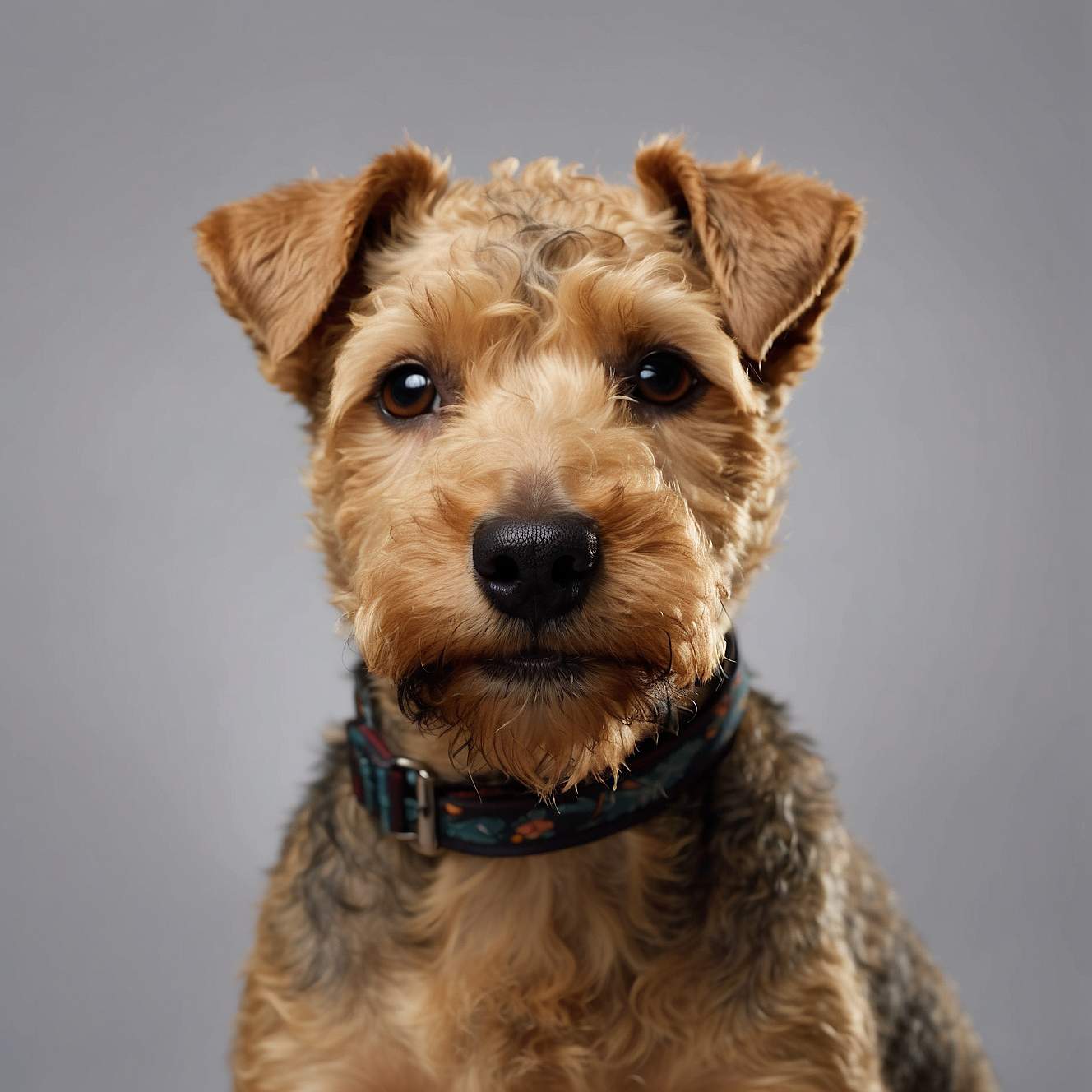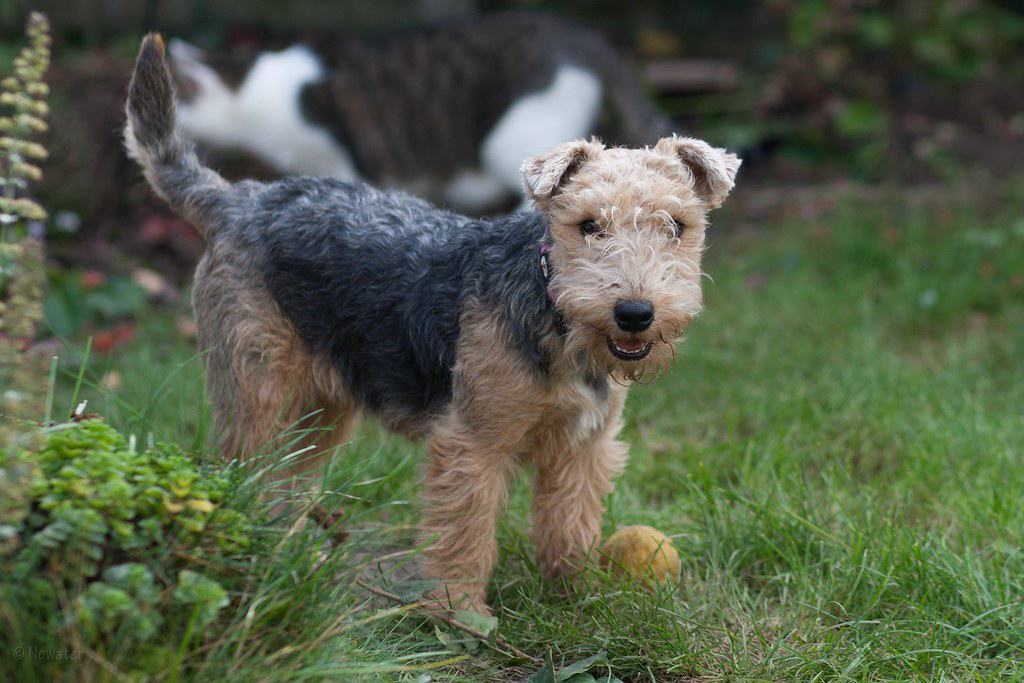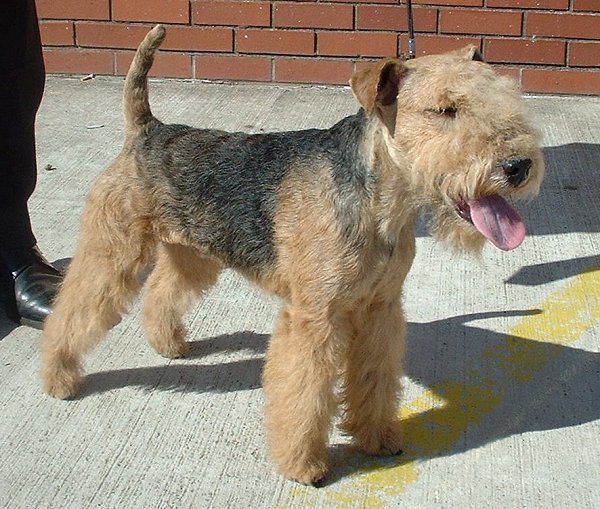The Lakeland Terrier, a small yet sturdy breed, is characterized by its long, dense coat and confident demeanor. Hailing from the Lake District in England, this terrier was originally bred for fox hunting. Today, it is a delightful companion appreciated for its intelligence, loyalty, and spirited nature. The Lakeland Terrier’s compact size and friendly disposition make it a wonderful addition to families seeking a lively and affectionate canine friend.

| Category (Explanation) | Breed Information |
|---|---|
| Year of Breed Conception | 19th century |
| Country of Origin | United Kingdom |
| Weight (lbs & kg) (Male) | 15 lbs (7 kg) |
| Weight (lbs & kg) (Female) | 15 lbs (7 kg) |
| Coat Type | Double coat with wiry outer layer |
| Color Variations | Black, tan, red, wheaten, blue, liver, or black and tan |
| Shedding Level (Low, Moderate, High) | Low to Moderate |
| Height (cm & in) | 13-14 inches (33-36 cm) |
| Breed Size | Small |
| Trainability (Low, Moderate, High) | Moderate |
| Mental Needs (Low, Moderate, High) | Moderate |
| Intelligence Level (Low, Moderate, High) | Moderate |
| Energy Level (Low, Moderate, High) | Moderate |
| Agility (Low, Moderate, High) | High |
| Loyalty (Low, Moderate, High) | High |
| Playfulness (Low, Moderate, High) | High |
| Exercise Needs | Regular exercise and playtime |
| Guarding Proficiency (Low, Moderate, High) | Low |
| Sociability with Children (Low, Moderate, High) | High |
| Barking Level (Low, Moderate, High) | Moderate |
| Digging Tendency (Low, Moderate, High) | Moderate |
| Destructive Behavior (Low, Moderate, High) | Low |
| Drooling Level (Low, Moderate, High) | Low |
| Obedience Level (Low, Moderate, High) | Moderate |
| Apartment Friendly (Yes/No) | Can adapt to apartment living with sufficient exercise |
| Inherent Prey Drive | Moderate |
| Physical Risk to Others (Low, Moderate, High) | Low |
| Travel Fatality Risk (Low, Moderate, High) | Low |
| Allergen Potential | Low |
| Health Concerns (List of Common Health Concerns) | Lens Luxation, Hip Dysplasia, Allergies |
| Average Life Expectancy (Life Expectancy in Years) | 12-16 years |
Woof Mastery is reader supported and our articles may contain affiliate links.
Instead of running third party ads that we have no control of we only use links from high-quality companies we are directly partnered with. Making use of these links come at no cost to you our reader, and in many cases have the extra benefit of discounted rates or sign up bonuses.
If you’re interested you can read more about our affiliate policy here.
We appreciate your support and always insure that the products and services we recommend are high-quality, helpful and relevant to the subject at hand!
The Lakeland Terrier, with its roots in the Lake District of England, has a history steeped in its role as a working terrier. Developed in the 19th century, this breed was primarily used for fox hunting, showcasing its agility and determination in challenging terrains. The Lakeland Terrier’s compact size and friendly disposition made it a valued companion in both rural and urban settings. Over time, it transitioned into a delightful family pet, cherished for its intelligence, loyalty, and spirited nature.

The Lakeland Terrier is special for its rugged charm and friendly disposition. Known for its history as a fox hunter, this breed brings agility and determination to its role. What sets it apart is its ability to transition seamlessly from a working terrier to a beloved family companion. The Lakeland Terrier’s compact size, coupled with its loyalty and intelligence, makes it a special addition to households seeking a lively and affectionate canine friend that effortlessly combines tenacity with a gentle heart.
The Lakeland Terrier’s traditional role stems from its history in the Lake District of England, where it was developed for fox hunting. Known for its agility and determination, this terrier played a vital role in pursuing foxes in challenging terrains. Over time, it transitioned from a working terrier to a delightful family companion. The Lakeland Terrier’s traditional role continues today as a spirited and loyal companion, bringing its terrier energy and charm into households, showcasing its adaptability and friendly disposition.
Lakeland Terriers are characterized by their rugged charm and friendly disposition. Known for their history in fox hunting, they possess agility and determination. These terriers have transitioned seamlessly from working roles to beloved family companions. Lakeland Terriers are loyal and intelligent, forming strong bonds with their families. They showcase a spirited personality and can adapt well to various environments. With their compact size and friendly demeanor, they make delightful additions to households, bringing both tenacity and affection to those who welcome them into their lives.
Lakeland Terriers are known for their friendly and determined temperament. They have a history in fox hunting, showcasing agility and tenacity. With proper training and socialization, they transition seamlessly into beloved family companions. Lakeland Terriers are loyal and form strong bonds with their families. While they may be reserved with strangers, they usually warm up with time. Supervision is recommended around other dogs, and introductions should be handled carefully. Their spirited personality and adaptability make them valuable additions to households, bringing both charm and loyalty to those who welcome them into their lives.
Lakeland Terriers are small to medium-sized dogs with a sturdy and well-proportioned build. They have a distinct head with a flat skull and a moderate stop. Their eyes are dark and alert, and their ears are small and folded forward. The breed has a dense, wiry coat that comes in various colors, including blue, black, red, wheat, or liver. Lakeland Terriers have a straight back, a high-set tail, and a brisk, confident gait. They convey a sense of determination, agility, and charm.
Lakeland Terriers come in various color variations, adding to their spirited and charming appearance. The most common color variations for Lakeland Terriers include:
Lakeland Terriers can exhibit various coat patterns, including solid colors or a mix of colors. The breed’s coat is dense, wiry, and straight, providing protection and showcasing its charming appearance. Lakeland Terriers may have markings or patterns, and the coat color should be rich and vibrant. While variations in coat pattern may occur, the breed’s distinctive head, alert expression, and well-defined coat colors contribute to its overall appeal and make it a cherished companion.
Lakeland Terriers have a low shedding level. Their dense, wiry coat sheds minimally, and regular grooming is necessary to maintain coat health. Brushing the coat once or twice a week helps remove loose fur and prevents matting. While Lakeland Terriers are not heavy shedders, grooming practices are essential to ensure their coat remains in good condition.
Lakeland Terriers have a double coat that requires regular grooming to keep them clean and healthy. Grooming habits for Lakeland Terriers include:
Brushing: Regular brushing with a slicker brush helps remove loose hair and prevents matting. This should be done a few times a week.
Bathing: Lakeland Terriers should be bathed regularly, approximately every three to six weeks, to keep their coat clean. Use a dog shampoo suitable for their coat type.
Ears: Check and clean their ears regularly to prevent wax buildup or infections. Use a damp cotton ball or a veterinarian-recommended ear cleaning solution.
Nails: Keep their nails trimmed to a comfortable length to prevent discomfort and maintain proper foot health.
Teeth: Brush their teeth regularly with a dog-friendly toothbrush and toothpaste. Dental chews or toys can also contribute to oral health.
Eye Care: Monitor their eyes for signs of irritation or discharge. If necessary, use a damp cloth to clean around the eye area.
Lakeland Terriers have a moderate activity level. These small terriers enjoy playtime and daily walks to meet their exercise needs. While they are not excessively hyperactive, providing mental stimulation through training sessions and interactive toys is beneficial. Lakeland Terriers thrive on companionship and may enjoy participating in activities with their owners.
Lakeland Terriers showcase intelligence in their energetic and bold nature. Their problem-solving abilities, combined with a lively spirit, make them adaptable to training. Positive reinforcement techniques and activities that stimulate their minds contribute to their overall intelligence and well-rounded personalities.
Lakeland Terriers have a need for mental stimulation. Engage them in activities like puzzle toys and interactive games that challenge their minds. Regular social interaction is crucial, as they are social dogs. Obedience training provides mental stimulation and strengthens the bond with their owners. Offering a routine, affection, and a safe environment contributes to their mental well-being.
Enter The Woof Mastery

Before bringing a Lakeland Terrier into your home, consider the following:
Lakeland Terriers, being lively and active, may pose a risk if not properly trained and socialized. Early socialization and consistent training are essential to manage their energy levels and prevent any potential risks. Owners should focus on positive reinforcement techniques to ensure they respond well to commands and are comfortable around others.
Lakeland Terriers, being lively, may enjoy playtime with older children. Supervision is important due to their energy levels. Early socialization and consistent training are crucial to ensure they are well-behaved around children. Their alert and friendly nature may make them suitable companions for families with older children.
Lakeland Terriers may have varied responses to water. Some individuals may enjoy swimming, while others may not be as comfortable. If you wish to introduce them to water, do so gradually and in a controlled environment. Always prioritize safety and use a canine life vest if needed.
Remember that Lakeland Terrier puppies, like all puppies, are eager to please and learn. Positive and consistent training practices will help them become well-behaved, obedient, and happy adult dogs. Building a strong and trusting bond with your puppy through training is a rewarding experience for both you and your canine companion.
Lakeland Terriers may bark to alert their owners or in response to various stimuli. Proper training and socialization are essential to manage their barking tendencies. They are intelligent dogs that respond well to positive reinforcement methods.
Lakeland Terriers do well in homes with active owners who can provide regular exercise and play. They are adaptable to various living conditions, including apartments, but they need mental stimulation. Regular grooming is essential for coat maintenance. Socialization is important to prevent aggressive behavior. Positive reinforcement training is effective.
Traveling with Lakeland Terriers involves considerations for their size and activity levels. Use a suitable travel crate or restraint to ensure their safety. Plan for breaks during the journey for stretching, hydrating, and bathroom breaks. Address any anxiety through positive associations and familiar items. Choose airlines with policies accommodating their size if flying, and ensure compliance with crate requirements for air travel safety.
Lakeland Terriers may be susceptible to certain health concerns, and while not all individuals will experience these issues, it’s essential for owners to be aware of potential health problems. Common health risks in Lakeland Terriers include:
Regular veterinary check-ups, a balanced diet, preventive care, and early intervention can contribute to the overall well-being of Lakeland Terriers.
Proper nutrition is crucial for the health and well-being of Lakeland Terriers. Here are some nutritional habits and best practices to consider for this breed:
Breed-Specific Laws (BSL): Lakeland Terriers may be subject to breed-specific laws (BSL) in certain areas. These laws are often enacted at the local or municipal level and can vary widely from one jurisdiction to another.
Types of Restrictions: The specific restrictions imposed on Lakeland Terriers under BSL can include mandatory spaying/neutering, special licensing, liability insurance requirements, muzzling in public, and, in some cases, bans on ownership. The severity of these restrictions depends on local regulations.
Rationale for BSL: BSL is typically implemented based on concerns about public safety and perceived risks associated with specific breeds, often due to incidents involving dog attacks. While Lakeland Terriers are not inherently aggressive, they can be affected by BSL due to their physical resemblance to breeds that are sometimes included in these laws.
Controversy: It’s important to note that BSL is a controversial topic. Critics argue that it unfairly targets breeds rather than addressing individual dog behavior and that responsible ownership and training should be emphasized instead of breed-specific restrictions.
Local Regulations: To determine if there are breed-specific laws or restrictions regarding Lakeland Terriers in your area, you should check with your local animal control or government authorities. Be aware of and comply with any local regulations to ensure that you are in compliance with the law while owning a Lakeland Terrier.
Woof Mastery is reader supported and our articles may contain affiliate links.
Instead of running third party ads that we have no control of we only use links from high-quality companies we are directly partnered with. Making use of these links come at no cost to you our reader, and in many cases have the extra benefit of discounted rates or sign up bonuses.
If you’re interested you can read more about our affiliate policy here.
We appreciate your support and always insure that the products and services we recommend are high-quality, helpful and relevant to the subject at hand!
Myth 1: Lakeland Terriers are High-Maintenance Grooming Dogs
Myth 2: They are Not Good with Children
Myth 3: They are All High-Energy Dogs
Myth 4: They are Not Suitable for Apartment Living
Myth 5: They are All Stubborn and Hard to Train
Myth 6: They are Prone to Excessive Barking
Myth 7: They Don’t Get Along with Other Pets
Myth 8: They are All the Same in Size and Appearance
Myth 9: They Don’t Need Regular Exercise
Myth 10: They are Not Affectionate
Understanding the true characteristics of Lakeland Terriers helps promote responsible ownership and a positive relationship with these charming terriers.
Famous Lakeland Terrier examples are not as widely documented, but these spunky and courageous dogs can be found in homes where their lively nature is appreciated.
The Lakeland Terrier is culturally significant as a breed with a bold and friendly nature. Known for their distinctive coat and energetic personality, Lakelands have become cherished companions. Their historical role as farm dogs and their appearance in popular media contribute to their cultural recognition. Lakeland Terriers are symbols of agility and companionship, finding a place in the hearts of dog enthusiasts who appreciate their lively and endearing qualities.
The Lakeland Terrier is culturally significant as a breed with a bold and friendly nature. Known for their distinctive coat and energetic personality, Lakelands have become cherished companions. Their historical role as farm dogs and their appearance in popular media contribute to their cultural recognition. Lakeland Terriers are symbols of agility and companionship, finding a place in the hearts of dog enthusiasts who appreciate their lively and endearing qualities.
Lakeland Terriers, like many terrier breeds, have faced specific challenges and considerations. Some of the notable challenges include:
The Lakeland Terrier is a terrier breed developed in the Lake District of England. Contributing breeds may include:
Lakeland Terriers are spirited and affectionate companions that bring a lively presence to any home. Known for their friendly disposition, they make excellent family pets. Their adaptability to different living conditions allows them to thrive in various settings. Engaging in activities that stimulate their minds and bodies enhances their well-being and strengthens the bond they share with their families. With their charming appearance and playful nature, Lakeland Terriers become cherished members of the household, offering both companionship and joy.